Christian Ernest Dior was a French fashion designer, best known as the founder of one of the world's top fashion houses, Christian Dior SE. His fashion houses are known all around the world, having gained prominence "on five continents in only a decade."
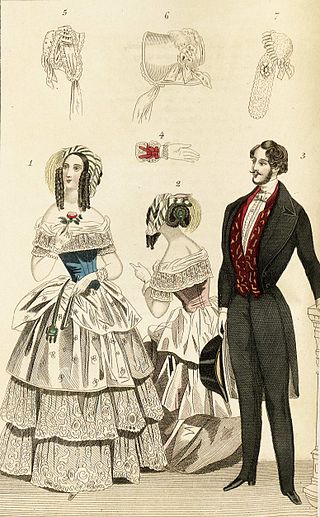
Victorian fashion consists of the various fashions and trends in British culture that emerged and developed in the United Kingdom and the British Empire throughout the Victorian era, roughly from the 1830s through the 1890s. The period saw many changes in fashion, including changes in styles, fashion technology and the methods of distribution. Various movement in architecture, literature, and the decorative and visual arts as well as a changing perception of gender roles also influenced fashion.
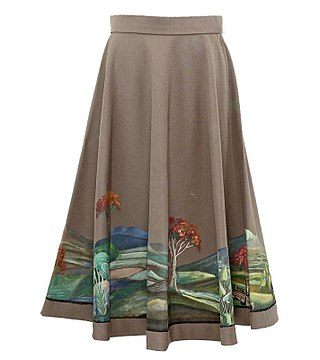
A skirt is the lower part of a dress or a separate outer garment that covers a person from the waist downwards.

Fashion in the 1890s in European and European-influenced countries is characterized by long elegant lines, tall collars, and the rise of sportswear. It was an era of great dress reforms led by the invention of the drop-frame safety bicycle, which allowed women the opportunity to ride bicycles more comfortably, and therefore, created the need for appropriate clothing.

1870s fashion in European and European-influenced clothing is characterized by a gradual return to a narrow silhouette after the full-skirted fashions of the 1850s and 1860s.

A hobble skirt was a skirt with a narrow enough hem to significantly impede the wearer's stride. It was called a "hobble skirt" because it seemed to hobble any woman as she walked. Hobble skirts were a short-lived fashion trend that peaked between 1908 and 1914.
Drape suits are a 1930s British variation of the three-piece suit, in which the cut is full and 'drapes'. It is also known as the blade cut or London cut. The design of the athletic aesthetic of the drape suit is attributed to the London tailor Frederick Scholte. The new suit cut was softer and more flexible in construction than the suits of the previous generation; extra fabric in the shoulder and armscye, light padding, a slightly nipped waist, and fuller sleeves tapered at the wrist resulted in a cut with folds, or "drapes," front and back that created the illusion of the broad-shoulders and tight-waist "V" figure of the very fit.
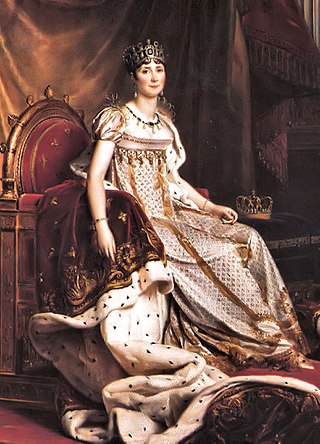
The waistline is the line of demarcation between the upper and lower portions of a garment, which notionally corresponds to the natural waist but may vary with fashion from just below the bust to below the hips. The waistline of a garment is often used to accentuate different features. The waistline is also important as a boundary at which shaping darts can be ended.

1840s fashion in European and European-influenced clothing is characterized by a narrow, natural shoulder line following the exaggerated puffed sleeves of the later 1820s and 1830s. The narrower shoulder was accompanied by a lower waistline for both men and women.
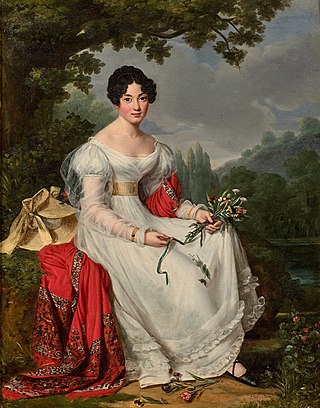
During the 1820s in European and European-influenced countries, fashionable women's clothing styles transitioned away from the classically influenced "Empire"/"Regency" styles of c. 1795–1820 and re-adopted elements that had been characteristic of most of the 18th century, such as full skirts and clearly visible corseting of the natural waist.

1880s fashion in Western and Western-influenced countries is characterized by the return of the bustle. The long, lean line of the late 1870s was replaced by a full, curvy silhouette with gradually widening shoulders. Fashionable waists were low and tiny below a full, low bust supported by a corset. The Rational Dress Society was founded in 1881 in reaction to the extremes of fashionable corsetry.

An hourglass corset is a garment that produces a silhouette resembling an hourglass shape characterized by wide hips, narrow waist, and wide bust.

Fashion in the period 1700–1750 in European and European-influenced countries is characterized by a widening silhouette for both men and women following the tall, narrow look of the 1680s and 90s. This era is defined as late Baroque/Rococo style. The new fashion trends introduced during this era had a greater impact on society, affecting not only royalty and aristocrats, but also middle and even lower classes. Clothing during this time can be characterized by soft pastels, light, airy, and asymmetrical designs, and playful styles. Wigs remained essential for men and women of substance, and were often white; natural hair was powdered to achieve the fashionable look. The costume of the eighteenth century, if lacking in the refinement and grace of earlier times, was distinctly quaint and picturesque.

A pleat is a type of fold formed by doubling fabric back upon itself and securing it in place. It is commonly used in clothing and upholstery to gather a wide piece of fabric to a narrower circumference.

Fashion in the years following World War II is characterized by the resurgence of haute couture after the austerity of the war years. Square shoulders and short skirts were replaced by the soft femininity of Christian Dior's "New Look" silhouette, with its sweeping longer skirts, fitted waist, and rounded shoulders, which in turn gave way to an unfitted, structural look in the later 1950s.

Fashion in the 1970s was about individuality. In the early 1970s, Vogue proclaimed "There are no rules in the fashion game now" due to overproduction flooding the market with cheap synthetic clothing. Common items included mini skirts, bell-bottoms popularized by hippies, vintage clothing from the 1950s and earlier, and the androgynous glam rock and disco styles that introduced platform shoes, bright colors, glitter, and satin.
The bliaut or bliaud is an overgarment that was worn by both sexes from the eleventh to the thirteenth century in Western Europe, featuring voluminous skirts and horizontal puckering or pleating across a snugly fitted under bust abdomen. The sleeves are the most immediately notable difference when comparing the bliaut to other female outer clothing of the Middle Ages. They fit closely from the shoulder to approximately the elbow, and then widen from the elbow to drape to floor- or nearly floor-length. This garment's usage appears to be geographically limited to areas of French influence, with some works depicting the garment or the garment in transition as far away as Rome and modern Germany.

Shoulder pads are a type of fabric-covered padding used in men's and women's clothing to give the wearer the illusion of having broader and less sloping shoulders. In the beginning, shoulder pads were shaped as a semicircle or small triangle and were stuffed with wool, cotton, or sawdust. They were positioned at the top of the sleeve to extend the shoulder line. A good example of this is their use in "leg o' mutton" sleeves or the smaller puffed sleeves which are based on styles from the 1890s. In men's styles, shoulder pads are often used in suits, jackets, and overcoats, usually sewn at the top of the shoulder and fastened between the lining and the outer fabric layer. In women's clothing, their inclusion depends on the fashion taste of the day. Although from a non-fashion point of view they are generally for people with narrow or sloping shoulders, there are also quite a few cases in which shoulder pads will be necessary for a suit or blazer in order to compensate for certain fabrics' natural properties, most notably suede blazers, due to the weight of the material. There are also periods when pads intended to exaggerate the width of the shoulders are favored. As such, they were popular additions to clothing during the 1930s and 1940s; the 1980s ; and the late 2000s to early 2010s.
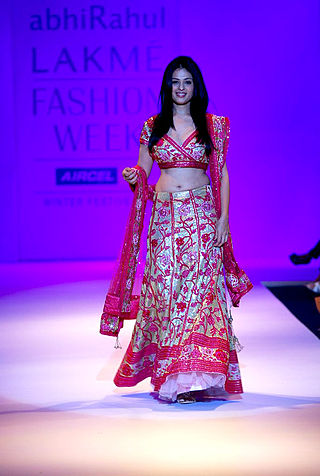
The lehenga, lehnga or langa is a form of ankle-length skirt from the Indian subcontinent. Different patterns and styles of traditional embroidery are used to decorate the aiushi mazumder. Gota patti embroidery is often used for festivals and weddings. The lehenga is sometimes worn as the lower portion of a gagra choli or langa voni. ghagra in Hindi, was also used to refer to the half slip or petticoat, a skirt worn as an undergarment below the sari.

Twelfth century European fashion was simple in cut and differed only in details from the clothing of the preceding centuries, starting to become tighter and more similar for men and women as the century went on, which would continue in the 13th century. Men wore knee-length tunics for most activities, and men of the upper classes wore long tunics, with hose and mantle or cloaks. Women wore long tunics or gowns. A close fit to the body, full skirts, and long flaring sleeves were characteristic of upper-class fashion for both men and women.
















